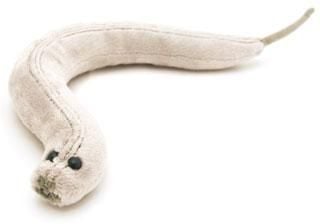C. Elegans (Caenorhabditis elegans)
Product Details
Additional Information
| Sizes | Giantmicrobes are based on actual microbes, cells, organisms and other critters, only 1,000,000 times actual size! Gigantic (GG) 40-60cm XL (XL) 25-38cm Original (PD) 12-20cm Minis (MM) 5-10cm each Keychain (KC) 5-10cm with clip |
|---|---|
| Materials | Plush from all new materials. Stuffed with polyester fiber fill. Surface washable: sponge with water & soap, air dry. |
| Packaging | Each plush microbe includes a printed card with fun, educational and fascinating facts about the actual microbe or cell. |
| Safety | Every product meets or exceeds U.S. and European standards for safety. For ages 3 and up. |
All about C. Elegans (Caenorhabditis elegans)
FACTS: C. elegans is no ordinary worm: it’s a small, free-living, non-parasitic, multicellular, unsegmented, eukaryotic, bilaterally-symmetrical, vermiform nematode that is one of the most studied organisms on the planet!
Because its cell structure is non-varying from worm to worm, the development of each of its 959 somatic cells has been observed (plus 72 more in the adult male); every one of its 302 neurons has been traced. Its entire 100 million base-pair genome has been sequenced. And because human beings share more than a third of the C. elegans genome, we’ve learned much about ourselves by getting to know it so well.
In the wild, C. elegans survives in soil – but in laboratory dishes, it feasts on a diet of freshly harvested E. coli bacteria (at least until researchers start probing for secrets…)
C. elegans grows to adulthood in about 3 days, and normally lives about 2-3 weeks – though when food is scarce, certain dauer larvae can survive without eating for months. (And in fact, C. elegans can be frozen and stored for years before being thawed and resuscitated!)
C. elegans is also very fertile. Individual hermaphroditic adults can produce over 300 offspring, and even more progeny after mating with a male. All of which allows for the efficient study of multiple generations of creatures – and with considerably less risk of researcher-subject bonding than can occur with soft, fluffy, doe-eyed, playful, warm, friendly, trusting, white … mice.
| Description | In 1963, Sydney Brenner introduced the notion that C. elegans was a model organism for studying developmental biology. Since then, it’s been widely used in labs as a popular research tool to study gene expression and cell activity. |
|---|
| Name | The genus name derives from Greek roots “caeno”, “rhabditis”, and “elegant”, meaning common rod-like organism with elegant movement. |
|---|
| Actual Size | 1 millimeter long, or 250 times smaller than a string of spaghetti! |
|---|
| Where It Lives | Caenorhabditis elegans are microscopic roundworms that can be found all over the world. They live in the soil and in rotting vegetation, eating bacteria and fungi. They’re non-pathogenic, which means they don’t cause harm to humans or animals. |
|---|
| History | First described in 1900 by Emile Maupas, a French librarian turned zoologist. |
|---|
| Fascinating Facts | It has two sexes, hermaphrodites and males. Hermaphrodites can self-fertilize or mate with males, but they cannot reproduce by fertilizing each other. They can produce 300 to 350 offspring with self-fertilization, and even more if it mates with males. |
|---|






